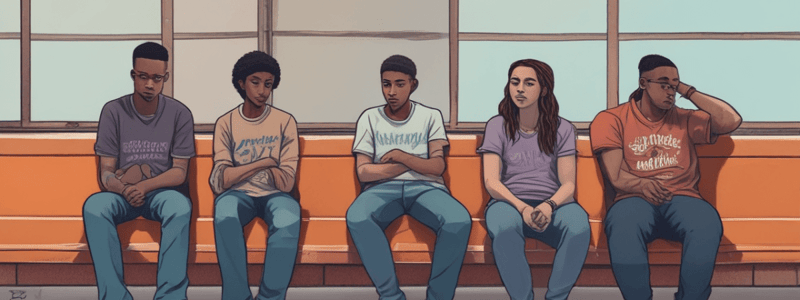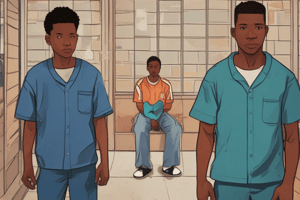Podcast
Questions and Answers
True or false:Punitive juvenile justice policies were implemented in the 1880s.
True or false:Punitive juvenile justice policies were implemented in the 1880s.
False (B)
True or false: Adolescents are not different from young adults in terms of decision-making.
True or false: Adolescents are not different from young adults in terms of decision-making.
False (B)
True or false: Strict punishment has a significant deterrence effect on adolescents.
True or false: Strict punishment has a significant deterrence effect on adolescents.
False (B)
True or false: Zero tolerance policies allow for mitigating circumstances in cases of discipline problems at school.
True or false: Zero tolerance policies allow for mitigating circumstances in cases of discipline problems at school.
True or false: Dropout rates impact all students equally.
True or false: Dropout rates impact all students equally.
True or false: Law enforcement's decision-making process when dealing with youthful offenders is not influenced by any external factors.
True or false: Law enforcement's decision-making process when dealing with youthful offenders is not influenced by any external factors.
True or false: Delinquency adjudication does not provide legal control over the juvenile to the court.
True or false: Delinquency adjudication does not provide legal control over the juvenile to the court.
True or false: Troubled lives before entering the system, academic struggles, and mental health issues are not common among youthful incarcerated offenders.
True or false: Troubled lives before entering the system, academic struggles, and mental health issues are not common among youthful incarcerated offenders.
True or false: Placement in a juvenile justice facility is associated with a decrease in recidivism rates.
True or false: Placement in a juvenile justice facility is associated with a decrease in recidivism rates.
True or false: Suicide prevention measures are unnecessary in juvenile justice facilities.
True or false: Suicide prevention measures are unnecessary in juvenile justice facilities.
Flashcards are hidden until you start studying
Study Notes
- Punitive juvenile justice policies began in the 1980s and have drawn millions of at-risk children into punishment pathways.
- Adolescents are different from young adults in terms of biology, cognition, emotion, socialization, and decision-making.
- Strict punishment has little deterrence effect on adolescents, and adolescent activities are part of identity formation.
- Discipline problems at school often start as minor incidents or infractions, but zero tolerance policies do not allow for mitigating circumstances.
- Dropout rates disproportionately impact minority and foreign-born students, LGBT, and males, and suspensions/expulsions increase the chance of school failure and juvenile court involvement.
- Law enforcement's first point of contact with youthful offenders can be pivotal, and the factors that influence their decisions include the young person's profile, the officer's perspectives, organizational policies, specific offenses, available community alternatives or programming, and any community pressures.
- Delinquency adjudication is an official judicial decision that provides legal control over the juvenile to the court and the assignment of a probation officer and ongoing supervision.
- Troubled lives before entering the system, academic struggles, and mental health issues are common among youthful incarcerated offenders.
- Most juvenile justice detention and incarceration facilities use punitive approaches, and placement in a facility has no correlation with recidivism rates or is associated with an increase in recidivism.
- Solitary confinement is cruel and unusual punishment that harms youthful offenders' development, mental health, and safety.
- Detained and incarcerated youthful offenders are at higher risk for suicide.
- Institutionalized adolescents have a 50% chance of experiencing suicidal thoughts.
- Predicting suicide risk in this population is difficult.
- Youth with an arrest history are more likely to report a suicide attempt.
- Maltreatment victims are twice as likely to attempt suicide in juvenile justice facilities.
- The system is not designed to handle the comorbid impact of suicide in detention and incarceration facilities.
- Risk factors for suicide vary in impact and intensity.
- Suicide prevention measures are necessary in juvenile justice facilities.
- Mental health support is crucial for incarcerated youth.
- More research is needed to understand and address the issue of suicide in detained and incarcerated youthful offenders.
Studying That Suits You
Use AI to generate personalized quizzes and flashcards to suit your learning preferences.



